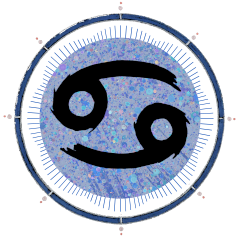 Dear Friend and Reader:
Dear Friend and Reader:
A CLUSTER of events the next few days is sending up an Aries Point alert: that is, global events on the horizon. The Sun is about to enter Capricorn for the southern solstice on Dec. 22 (winter solstice, up in the northern hemisphere). Jupiter, the Sun and Mercury are either in Capricorn or will get there within moments, with Pluto right behind. Then the Sun and Moon oppose one another (also called the Full Moon) across early Cancer/Capricorn on Dec. 24.
When a lunation occurs along an axis where there are many planets, it tends to precipitate global activity. Because this particular one occurs near the Aries Point (making a conjunction, square or opposition aspect to the first degree of Aries; in this case, a square or 90 degree angles from Cancer and Cap) the news tends to have a personal feel to it and/or it affects a lot of people. These developments are part of a pattern covered recently in this space.
In any event, the combination of a Full Moon near the solstice will make for a lively holiday environment, full of polarized discussions, intense emotions and of course some histrionics sponsored by those who can’t quite keep a grip when the astrology hots up. The Moon is full in a very close conjunction to retrograde Mars in Cancer. For those who never miss an opportunity to overreact, you will be in the right place. As one who follows astrology, you can be mindful of the environment you’re in, preparing like one who takes an umbrella when it looks like rain.
All the emphasis on Capricorn is good for what drives the holiday season in the Western world, a sense of obligation and a certain innocence about doing business. Cap is also in many respects the sign of families and things like the “institution” of marriage and of the family. This is some well-deserved support coming our way.
Jupiter in Capricorn could have one of two influences: protection, or magnifying whatever happens. Conceivably it could do both at once. It’s never a good idea to make predictions unless it’s part of a game, but this alignment is begging for them. The problem with astrology’s predictions is they tend to be of two varieties: either the world is going to end, or humanity will suddenly ascend to the 5th dimension and we will all become enlightened.
We need to take a more practical, contemplative view. I propose we seek a future different than the past. Many people take a cynical view of the future, but we don’t know what’s going to happen this time around. We often forget we make the future, but it’s never too late to remember. It’s never too early, either.
Keep your antennae up. Pay attention six ways from Sunday, and remember astrology when you’re watching the news, or watching yourself.
![]()
Nexus: Astrology and Ecology

IN OTHER NEWS, we now live in a solar system where there are about a quarter-million known objects orbiting our own Sun. Some have names. Many do not, they just have numbers or provisional designations.
Most people are stunned to learn this information, but it’s true. Whole new classes of planets have been born in recent years. Some are Centaurs, like Chiron, which shuttle between the inner solar system and the outer (coming inside the orbit of Saturn and even Jupiter, and extending out to Uranus, Neptune or Pluto). Others are members of the Kuiper Belt or Oort Cloud, vast regions of space around and beyond Pluto (Orcus, Varuna, Sedna). Some defy easy categorization (such as Cyllarus, which is considered a Centaur but which goes out well past Pluto).
New discoveries are named by astronomers, who are part of our culture. Most have trouble recognizing the validity of astrology. Yet they respond to the world around them, and interrelate with the same symbols and references available to everyone else. Their naming choices are recorded perpetually in scientific history, creating a kind of diary of the times in which we live. In doing so, they are resurrecting the ancient gods and goddesses and placing them and their stories into public consciousness, sending us a message about what’s happening in our world. It is interesting that folklore is now in the hands of scientists, who are effective at using it. We are being called through the awakening of ancient myths to pay attention to what is happening to our world right now.
Together, many of the recent names tell a story, one we’ve seen being acted out in the news in the past decade. Looking at several planets named in recent years, I see a pattern of naming choices related to the climate crisis.

Let’s begin with Ceres, the first asteroid, named for the goddess of food and the patron of grieving mothers. She was discovered on Jan. 1, 1801 (the first day of the 19th century) and declared a planet, but was promptly relegated to asteroid status by science, and for the most part has been ignored by astrology. She was revived from obscurity and designated a dwarf planet in the summer of 2006, at the same time as Pluto and Eris, putting these three on the same level of consciousness. Ceres is about food, and our current ecological crises come back to food every way you look at it.
I’ll give two examples. Food is related to petroleum and thus to the core environmental crisis; in many ways, it is petroleum. We must plow oil into the ground, in the form of fertilizers, pesticides, and the energy used for irrigation and farm equipment, in order to get anything back out of the ground.
Second, we have companies such as Monsanto taking over the biosphere with genetically modified plants. We have many reasons to be suspicious about the Frankenstein DNA of these plants, including what it does to us and to everything else that grows, but we never let this issue see the light of consciousness.
With Ceres, we have a combination of the themes of mother, food and loss/grief, which aptly fits our times today. She is the astrological stand-in for the struggle of Mother Earth, the nurturer. Interestingly, though, she was in the ascendant of the chart for the SUNY New Paltz PCB disaster.
Most of us have heard of Eris, a planet larger than Pluto that upset the known order of the solar system in the summer of 2006. She is the goddess of discord (named Discordia in Roman myth), though astrologically planets are always about more than their myths. Eris (originally called Xena or 2003 UB313), she gets more attention than any other minor planet, but for the most part, astrology still has no clue what to do with her.
Eris is currently the most distant known planet. If she is the goddess of discord and chaos, that is an invitation to take notice of the hormone chaos being created by the numerous pollutants we are exposed to. Today, the word ‘pollution’ is synonymous with hormone pollution: chemicals from aluminum to pesticides act as hormones in our bodies.
Many mimic estrogen, the main female sex hormone. This may help explain why sexual cancer rates are so high, why men today have half the sperm counts of their grandfathers, and why there are so many Viagra ads in your inbox. Eris was photographed in 2003, discovered in 2005 and named in 2006. She has an orbit of 557 years.* While I feel that Eris is most meaningfully considered as a means to understanding the chaos of our self-identity at this point in history, I am sure that much of that turmoil involves the condition of our endocrine systems. We are in a state of hormone vertigo that messes with our experience of gender, of one another, and with our feelings and internal messages in general. Think about that next time you see smoke pouring out of a smokestack.
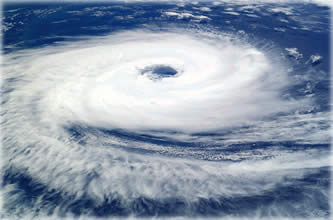
Much of the planetary crisis involves water. Two recent discoveries were named for gods of water in a time when flooding is one of the dominant news items, as well as the health of the seas and freshwater bodies.
Varuna was a supreme pre-Vedic deity, and was also the lord of waters. He has influence in the levels of seas, streams and rivers, and most meaningfully, the failure to be responsible for our actions. Like Orcus, he’s responsible for punishing those who don’t honor contracts. Varuna was discovered in 2000 and has an orbit of 281 years. I call Varuna “the great equalizer.” On a collective scale, this planet is calling us to take both personal and collective responsibility for our world.
Second is Deucalion, the Greek equivalent of biblical Noah. This planet was discovered in 1999 (the year of the grand cross/ total solar eclipse) and has an orbital period of 295 years. Deucalion has a complicated myth, one that you did not hear in school. Part of the story goes as follows.
“So Zeus set upon loosing a deluge, where the rivers would run in torrents and the sea encroach rapidly on the coastal plain, engulf the foothills with spray, and wash everything clean,” Wikipedia writes. “Deucalion was to build an ark and provision it carefully (no animals are rescued in this version of the Flood myth), so that when the waters receded after nine days, he and his wife Pyrrha, daughter of Epimetheus, were the one surviving pair of humans. Their ark touched solid ground on Mount Parnassus, or Mount Etna in Sicily, or Mount Athos in Chalcidice, or Mount Othrys in Thessaly.”
As far as the Greek myth is concerned, we are all descendents of Deucalion and Pyrrha. We had best remember him, and apply some of his ingenuity as the waters of the Earth rise up again.
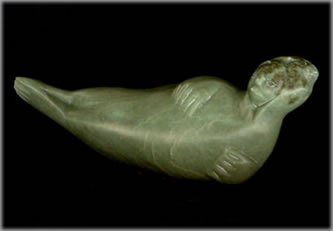
Sedna is one of the most important discoveries in recent scientific history, named for the Inuit goddess who lives beneath the sea at the North Pole. This body was discovered in 2003. It takes Sedna 10,666 years to go around the Sun once, more than 40 times longer than it takes Pluto and about 20 times longer than it takes Eris. Sedna is a resident of what is called the Oort Cloud, a region in space further away than the Kuiper Belt where Pluto and many other small worlds planets exist. (Note that though Eris has nearly twenty times shorter orbit than Sedna, she is currently significantly further out from the Sun than Sedna.)
Sedna is said to have created the dolphins, whales and other cetations that are the source of food for the Inuit, and which are being killed or dying off in great numbers today. This is in turn a reflection of the environmental and moral condition of our planet.
Related to Sedna is Orcus. While Orcus of myth is described in Wikipedia as “a god of the underworld, punisher of broken oaths, more equivalent to Pluto than to the Greek Hades,” he is the namesake of the orca whales (the supposed “killer whales”). Orcus has an orbit nearly identical to that of Pluto, 246 years. This planet was discovered in 2004.
Typhon was discovered in 2002, announcing an era when hurricanes and their resulting floods would dominate the news. Wiki tells us: “His name is apparently derived from the Greek ‘typhein’, to smoke, hence it is considered to be a possible etymology for the word typhoon, supposedly borrowed by the Persians and Arabs to describe the cyclonic storms of the Indian Ocean. The Greeks also frequently represented him as a storm-daemon, especially in the version where he stole Zeus’s thunderbolts and wrecked the earth with storms.”

Logos was discovered in 1997 and has an orbital period of about 305 years. Planet Waves astrologer Kirsti Melto has noted that this planet was prominent in the chart of the first computer program. Its name is the origin of the word and concept for language, which is prominent in any form of technology.
Logos was the actual Greek word used for “the word” in the phrase, “In the beginning was the word and the word was with God and the word was God.” So it’s an interesting paradox, it is both language, logic and its opposite — that for which there is no word, and cannot be expressed in words or understood by logic. This fits because computer programming is like playing god — creating life, artificial intelligence, robots etc; computers are very much a microcosm for our stage of understanding of how the world works.
Logos is also a concept from our own era. “The primary meaning of logos is: something said; by implication a subject, topic of discourse or reasoning. Secondary meanings such as logic, reasoning, etc. derive from the fact that if one is capable of…speech, then intelligence and reason are assumed.” We have an issue here, which is that in order to lie, we need language and we need to twist logic.
To do that, we must draw on the power of Ixion. Discovered in 2001 and having an orbital period of 250 years, Ixion was named for the first murderer recorded in Greek mythology (a former king and friend of Zeus). Ixion speaks to that which we are all capable of. While Ixion speaks to the truth that we really can do anything, this expresses itself more often negatively than not. How can oil executives rake in billions in profits while the planet plunges into climate turmoil? How can college administrators put students in dioxin contaminated dorms? For that, we need to have a long talk with Ixion.
Just What Are Those Galaxies Doing Out There?
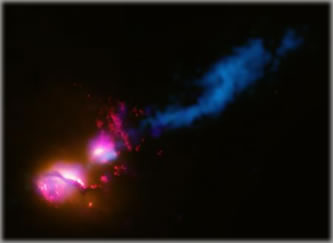
Play Video.
IN THE LATEST news report from deep space in the moment of the Spiral Door, two galaxies are doing something that scientists have never seen before.
A black hole in what’s been called a “death star galaxy” (about a trillion miles away from our blue rock) is blasting its neighboring galaxy with a jet of magnetic radiation. While this is being described as an extraordinary, never-before-seen act of intergalactic violence, how do we know whether these galaxies are having sex, killing one another, having lunch or doing the cosmic bugaloo?
The two galaxies orbiting each other are only 24,000 light years apart and are in a slow merging process. A disturbance in the magnetic field caused by this movement may have awakened a dormant black hole into lashing out. Or, their magnetic fields may have awakened deep cosmic desire that is leaping across intergalactic space. No more than a million years old, the jet “attack” is relatively new in deep space time and can stretch on for another 10 to 100 million years, according to scientists.
“The jet violently slams into that lower half of the neighboring galaxy after which the jet dramatically twists and bends,” said Daniel Evans of the Harvard-Smithsonian Center for Astrophysics, one of the researchers who discovered the phenomenon, and named it the “death star galaxy.”
When asked whether he was certain this was really an act of violence, Evans, the lead discoverer, told Planet Waves Thursday that, “The ultimate legacy may be the creation of new stars and new planets, because the jet could compress clouds of gas there,” leading to such new formations.
“It’s like a bully, a black-hole bully punching the nose of a passing galaxy,” said astrophysicist Neil deGrasse Tyson, director of the Hayden Planetarium in New York, who wasn’t involved in the research, in a published interview. I called him up Thursday and asked how he knew what the galaxies were actually doing, and how we knew it was violent and not something else.
“Their jets are in general rare, but you’ll always find somebody with a jet,” Tyson told Planet Waves. “Usually the jets are pointing in some direction that is not aimed at someone. This one is aimed at another galaxy. It’s fair to think of matter as something that forms by the action of gravity, and high energy radiation is something that destroys the structure of matter. So there is no other way to think of the word violence, except when something gets destroyed by some assault. It’s certainly damaging to biology. Any life form there would decompose. The energy is higher than the energy required to keep your molecules together. We could be dispassionate and say it breaks apart the molecules.”
I asked if he considers galaxies to be living things.
“If you look at most definitions for life, stars actually come very close to satisfying every one of those criteria. They have metabolism, they are born, they die. The problem is we only know what life is on Earth. You can’t make a generalized science proclamation on a sample of one. We are not in a position to say what’s alive and what is not alive except for what is on Earth. Given that we can play. Life cycle of a star, the birth life and death of a star, the evolution of a galaxy. We use the same vocabulary that biologists use. We can think of them metaphorically as being alive,” but not literally.
“We are saying that if you can’t define what life is because we only have one sample of what life is, then the word is not really secure yet. But astronomers could define life to be what a star is,” Tyson added.
“I don’t have a problem broadening the concept of life to think of these systems as being a form of life. It allows you to describe what is happening to them. But I never say these things are alive because it has too much pedagogical baggage” connected with doing so.
I asked how we know the galaxies are not having sex.
“Because we see jets in other contexts, and this one happens to have another galaxy in the line of fire. If they were having sex, you would see jets in all galaxies aiming straight for the nearby galaxies. If jets connecting two galaxies were something galaxies do regularly, we would see this as a common phenomenon. There are enough cases where we have neighboring galaxies where one of the jets would slam into a nearby galaxy. It’s rare. It’s a sample of one. But we have many neighboring galaxies and we have galaxies with jets. We don’t have to invent a new concept to know what we are looking at. It’s one, but it’s not a new idea that we have to invent. Whether it was sex or just something galaxies do,” we don’t see it often.
In other words, if it was sex, they would do it more often. But a lot of people say the same thing about their husband.
As we know from life here on planet Earth (with some help from our friend Pluto) matter cannot be destroyed — only transformed. Eventually the area of hot gas being compressed by this mysterious jet, over millions of years can lead to the creation of “stellar nurseries” and the birth of new stars. So voila, they are fucking after all.
Tyson said there are two main lessons to be learned from what the telescopes have found: “This is a reminder that you are not alone in the universe. You are not isolated. You are not an island.” And “avoid black holes when you can.” Be it in space or here on Earth, that’s sound advice.
By Eric Francis with research by Priya Kale
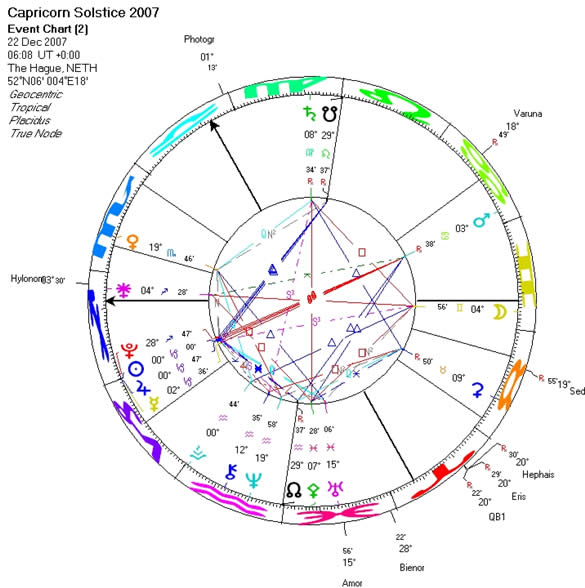
SOLSTICES ARE TIMES when the Sun in its apparent annual motion along the ecliptic reaches its northern and southern extremes. Astrology at the time of a solstice or equinox (the midpoints between the solstices) are often used as predictive tools by astrologers.
The Sun reaches its most southern point around Dec. 22 each year. This is when the Sun “stands still” at the first degree of Capricorn, hence the term sol (Sun) stice (still, as in stasis). The Sun is crossing one of the cardinal points (also known as the four directions, which are the first degrees of Aries, Cancer, Libra and Capricorn). The cardinal points are highly sensitive, all directly related to one another. They tend to arrive with the message that the personal is political. Planetary events near these points tend to connect us to the larger events and movements in society around us.
The current solstice chart looks noteworthy, accented by many points collecting around the first degree of Capricorn. There is not just the Sun there, but also Jupiter in the same degree, and Mercury and Pluto very close by, too. Pluto is still near the Galactic Core and the Sun and Mercury passed the point only some days earlier. Jupiter entered Capricorn Wed. night, Dec. 18. Mercury entered Capricorn on Dec. 20, and the exact Sun-Pluto conjunction occurs on Fri., Dec. 21. The quadruple conjunction of these planets suggests that something we will all notice is about to happen, a total rebirth or transformation.
True, this is happening all the time, but some times we notice more than others. The involvement of so many planets in a cardinal sign suggests that some pioneering work is going to arise, something that we all are going to notice; the involvement of Capricorn points to government or a large corporation, and the movement in Pluto into Capricorn talks about a restructuring of some kind in any event. When Chiron reached this point in late 2001, we saw massive corporate restructuring and many scandals were revealed.
Sun-Mercury-Jupiter conjunction also squares the Centaur planet Bienor, “the Strong One,” currently in the late degrees of Pisces. Bienor will be arriving in Aries soon enough and will be in a square aspect to Pluto through 2008.
Retrograding Mars in Cancer is also in the aspect structure. It will soon make exact oppositions to Mercury and Jupiter, and then the Sun and finally Pluto. Mars is acting both as a counter-balance in this equation and as a kind of protagonist. But Mars is retrograde in a receptive, emotional sign: it’s not likely making its presence known unless provoked, which would not be that difficult.
The Moon in early Gemini squares Saturn, which stationed retrograde in Virgo on Dec. 19. The Moon opposes asteroid Juno, the queen of the gods who was known for her jealousy, and the Centaur planet Hylonome, which has associations with grief, healing of unnecessary grief, and mass appeal.
Mercury, the planet of all communication, forms a very close novile (40 degrees, division of the circle by 9) to Chiron, who in mythology was a great teacher. The novile series of aspects are related to trines and sextiles, and they are said to be related to the Nine Muses, who offer their inspiration in the arts and sciences.
Venus in Scorpio squares Neptune and opposes Sedna, the goddess of the frozen waters. In this T-square we have two watery planets, Neptune and Sedna, and two goddesses of abundance, Venus and Sedna, aspecting each other. Venus is reminding us to keep our hearts open and to be compassionate, and in Scorpio on any theme associated with Venus: love, eroticism, or materialism. Square Neptune, we have the potential for unrealistic feelings and wishy-washy values slipping in. Those would be the presence of values we don’t really hold, or some form of self-deception.
The theme of universal love is repeated in the conjunction of asteroid Amor and Uranus in Pisces. The North Node of the Moon has recently entered Aquarius, the sign of universal brotherhood. Venus is also trining Varuna, “the great equalizer,” another water god.
In one of the cardinal points in the early degrees of Libra we have asteroid Photographica, which deals with all things photographic and photogenic, often manifesting in a literal way.
In Aries asteroid Hephaistos is in tight conjunction with Eris and 1992 QB1. In Greek mythology Hephaistos was the god of technology, blacksmiths, craftsmen, artisans, sculptors, metals and metallurgy, and fire. His Roman equivalent was Vulcan, husband of Venus.
What exactly this chart is heralding remains to be seen.
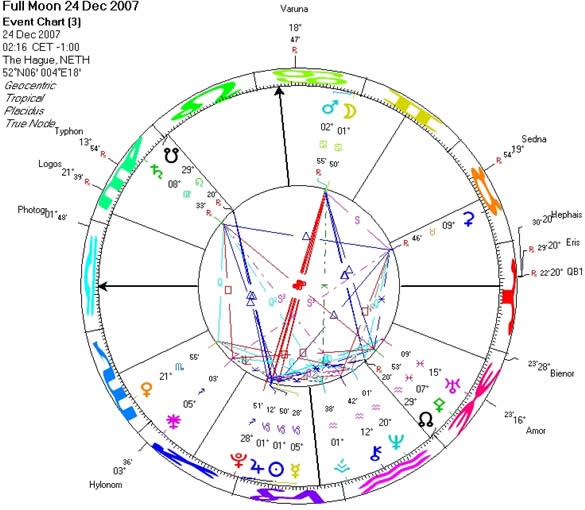
The Full Moon in Cancer occurs in the early hours of Christmas Eve. Now also the Moon is occupying one of the cardinal points. The chart is having a strong Aries Point flavor.
The Moon has entered Cancer a couple of hours before midnight (UT) and is conjunct Mars. Not much else has changed in the two days since the solstice. In Virgo two binary Kuiper belt objects have stationed retrograde meanwhile, Typhon and Logos.

Weekly Horoscope for Friday, Dec. 21, 2007, #694 – By ERIC FRANCIS
Aries (March 20-April 19)
Unusual developments this week promise to take you past any ambitions or professional desires you’ve been dreaming of lately. But don’t sell yourself short. Go for less money if it means reaching closer to your dreams. Go for less status if it means doing more of what you need to do. Your options are open, and at this stage even a delay of some weeks or months is better than making a choice that either feels premature or which you know is the wrong decision. Now, if you find yourself in a position of expanded influence or power, or even facing the possibility, you can be pretty sure you’re going to get a kickback of guilt, insecurity or fear. That is normal; it is in fact evidence that your mind is expanding, your world is enlarging and that you are taking on your true calling. Negative emotions exist no matter what; when you’re aware of them, you can let them go.
Taurus (April 19-May 20)
Planets are suddenly moving into earthy signs these days — in particular, Jupiter, Mercury and the Sun shifting into Capricorn, where they will pick up the energy of Saturn in Virgo. These planets are all making brilliant aspects to your Sun and possibly other natal planets: in other words, you have enormous support at the moment. It’s not going away any time soon, but you can consider yourself at a beginning in your life, and the beginning is no time to hesitate. In fact, this would be the best time in recent memory to throw your doubts to the four winds and make the choices that you know will lead to your greatest happiness. When planets group together in one element, the effect is a lot of trines. Trines are easy, but you have to work to make sure that they’re not lazy. If you do art, pull out the stops. If you are a traveler, set sail. If you are a lover, go for nights and days on end.
Gemini (May 20-June 21)
Your access to others, their resources and their support is increasing by the day; it is in truth increasing exponentially. Therefore, ask for the help you need, and don’t doubt or second-guess yourself. People are ready to assist you, even if they are markedly different than you are; even if they seem more conservative or reserved. The chances are they are radical in ways you cannot perceive at the moment, but which I assure you that within a short time you will get to see. In any situation, look for the common ground. You are not selling out your values by exploring the values of others, and you are not selling out yourself by adopting the values of someone who you truly respect. Just make sure you keep your self-respect if you find yourself making some radical adjustment to how you live or how you see the world.
Cancer (June 21-July 22)
You’re now finally seeing some of the promise that the world has been dangling out in front of you, and which you have so diligently been working for. Be mindful that the reward is one thing, but how far you have come on the way to getting there is the true gift of this situation. You have been on a long journey, and it has compelled you to mature, and to push yourself to fulfill your potential, and to stand at your full height. In a few days, the Full Moon in your birth sign is conjunct Mars, which is currently moving retrograde in your sign. This is a combination that seems perfect for some kind of emotional regrets, no matter how good your life is at the moment. I suggest you decide in advance that you have nothing to doubt, no reason to deny the past, and indeed, no reason to deny yourself. There are things you need — the ones that money cannot buy. Have faith that they too are arriving.
Leo (July 22-Aug. 23)
One of the hallmarks, indeed, one of the great gifts of the New Year is how much you are welcoming the prospect of doing good work. Having spent nearly four years in Europe, where people make fun of Americans because so many of us like to work, I have come to appreciate this aspect of the American character. I know you already do, much to the benefit of those around you. However, I trust that you are going to exceed all prior records or expectations, and the rewards (short term and long) will be enormous. That being said, I suggest you put equal investment into your health and wellbeing; that will, as well, bring you excellent returns.
Virgo (Aug. 23-Sep. 22)
You are getting to know yourself. Often the way people do this is by needing to make a move in their lives, encountering their inner resistance, feeling it for what it is, and then working through it. Other times, a bold message or feeling comes through that stretches our ability to contain or channel it, and then we have to develop the discipline and the structures to get the work done. This is basically the story of your life. Think like an artist, but think like an industrialist. What do you envision? How much space will it take? What equipment, how much money, and what human assistance? What sources of inspiration, and what in the way of time and emotional energy? Most of all, what risk would you need to take? Consider all of this more or less methodically, and get yourself going.
Libra (Sep. 22-Oct. 23)
I have noticed that the reason most people seem to fall short of their potential, particularly their creative potential, is that they don’t give themselves over to it. Looking from the outside, being an artist is a self-indulgent thing; you might lock yourself in your studio for hours and do your work. From the inside, a person doing that must surrender many other aspects of their mind and feelings, and block out numerous distractions and other needs, and relinquish themselves to the experience. Consider these carefully — I’m describing what would appear to be polar opposites in perception vs. experience. At the moment, you are being called to let go of yourself and surrender to something that can be described as creative in nature. This may be coming at a time when you have many other necessities, and when you don’t necessarily trust your perceptions. I suggest you allow none of that to get in your way.
Scorpio (Oct. 23-Nov. 22)
Before you decide that a close partner is delusional, out to lunch or pulling away, I suggest you investigate your own feelings. You are not exactly what I would call in total denial, but you are about to make contact with something that you’re not fully aware of. You can save yourself considerable anger and other forms of emotional energy by making contact with it now. If you go along proceeding blithely like nothing is bothering you, the most likely result will be that you will blow up in a rage. Worse, you will likely direct it at someone else when you’re actually angry with yourself. Neither is actually productive; neither will forward your cause, your relationships or the human race.
Sagittarius (Nov. 22-Dec. 22)
What are your actual resources? You seem to have a lot going for you. Money flows toward structure, and it seems to be doing plenty of that. Yet you have other resources that you may not be considering, and these are infinitely more valuable. One is experience. Another is a meaningful sense of the world and how it works. The most important one is your ability to tap into tradition and then do something new. However, your chart seems to indicate a struggle or a sticky growth point, and that is the one where ethics meets power. The power part, you understand. The past year has come with a seemingly endless progression of issues and questions where this has been a factor. The problem with power is that it knows nothing about ethics. The problem with ethics is that usually, nobody gives a shit. You are the mediator.
Capricorn (Dec. 22-Jan. 20)
Three planets have moved into your birth sign in the past few days. The Sun is at solstice, and in the Northern Hemisphere, the days are getting longer. You are, with any luck at all, feeling like you have a lot to offer the world, and like this is going to be an incredibly special year of your life. There may be a relationship or partnership matter that is irritating you, however. It may feel like the more you give, the more someone near you holds back. Remember something you have learned about your relationships, which is that they run in cycles that have nothing to do with you. But you can learn to follow those cycles, you will learn to pace your life so that you get all your needs met and you can take advantage of them, if you do.
Aquarius (Jan. 20-Feb. 19)
The focus of the sky is shifting rapidly to Capricorn, your 12th house of things too big to be seen, and the ancient Vedic house of pleasures of the bed. Now, few would associate Capricorn with hot sex, but you crave that grounding, sensuous and slow-vibrating energy that fills this house. It also seems too distant to reach most of the time, like it tantalizes you. I suggest you dedicate the coming four seasons of your life to reaching for the impossible. While Pluto in your 12th solar house can have a daunting, at times isolating quality, you are poised to discover that you are not really alone. While the stars seem poised to give you more of what you need than what you want, I suggest you keep your finger on the pulse of desire. It will not abandon you.
Pisces (Feb. 19-March 20)
You are about to find out who your friends are, and what they have to offer. You may be a person for whom the concept of ‘friend’ translates to ‘old friend’, but you are currently communing with people you have been traveling with over many lifetimes. Therefore, you may have met them yesterday, but it seems like you’ve known them forever. I would add a word of caution that this is not always a good thing, and when you encounter someone who is familiar you need to check the karma between you carefully. You have the right to choose those you associate with, and while we all have karma to work out, you have prerogatives about how you go about doing it. Exercise those choices carefully, but meanwhile remember this: besides your body and the breath of life that fills it, your community is your only real asset. Treat it well and it will treat you very well.



